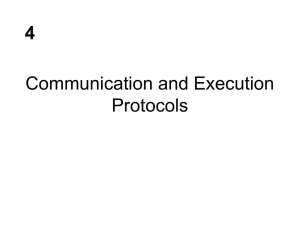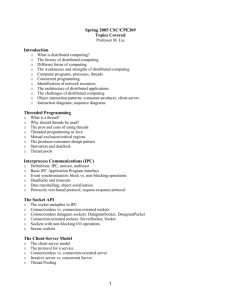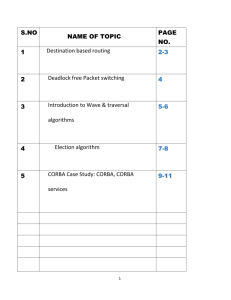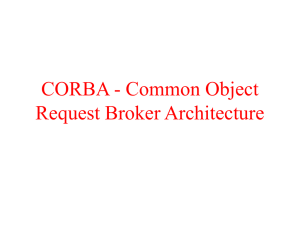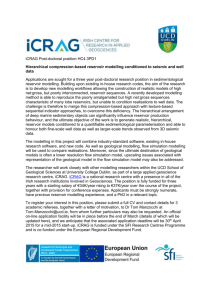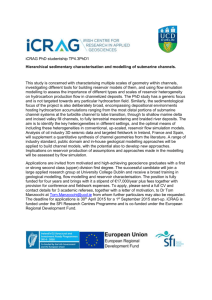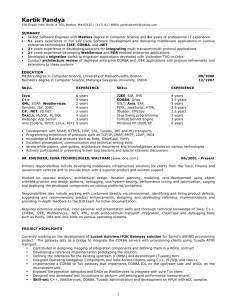Integration of GOCAD with an object-oriented geo
advertisement
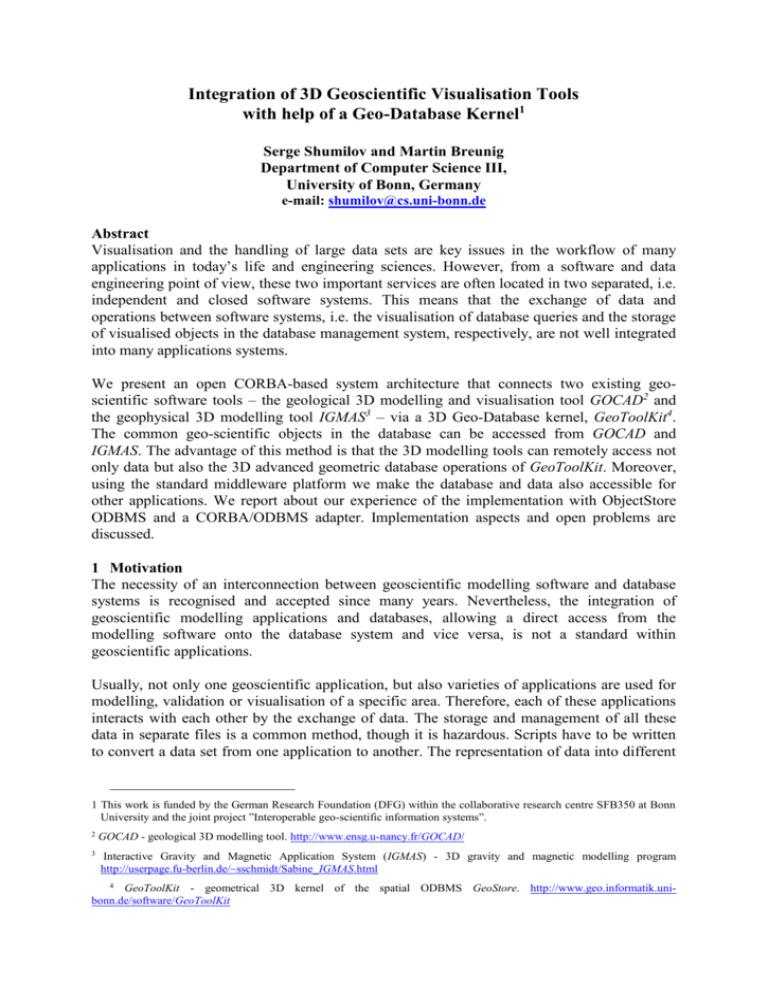
Integration of 3D Geoscientific Visualisation Tools
with help of a Geo-Database Kernel1
Serge Shumilov and Martin Breunig
Department of Computer Science III,
University of Bonn, Germany
e-mail: shumilov@cs.uni-bonn.de
Abstract
Visualisation and the handling of large data sets are key issues in the workflow of many
applications in today’s life and engineering sciences. However, from a software and data
engineering point of view, these two important services are often located in two separated, i.e.
independent and closed software systems. This means that the exchange of data and
operations between software systems, i.e. the visualisation of database queries and the storage
of visualised objects in the database management system, respectively, are not well integrated
into many applications systems.
We present an open CORBA-based system architecture that connects two existing geoscientific software tools – the geological 3D modelling and visualisation tool GOCAD2 and
the geophysical 3D modelling tool IGMAS3 – via a 3D Geo-Database kernel, GeoToolKit4.
The common geo-scientific objects in the database can be accessed from GOCAD and
IGMAS. The advantage of this method is that the 3D modelling tools can remotely access not
only data but also the 3D advanced geometric database operations of GeoToolKit. Moreover,
using the standard middleware platform we make the database and data also accessible for
other applications. We report about our experience of the implementation with ObjectStore
ODBMS and a CORBA/ODBMS adapter. Implementation aspects and open problems are
discussed.
1 Motivation
The necessity of an interconnection between geoscientific modelling software and database
systems is recognised and accepted since many years. Nevertheless, the integration of
geoscientific modelling applications and databases, allowing a direct access from the
modelling software onto the database system and vice versa, is not a standard within
geoscientific applications.
Usually, not only one geoscientific application, but also varieties of applications are used for
modelling, validation or visualisation of a specific area. Therefore, each of these applications
interacts with each other by the exchange of data. The storage and management of all these
data in separate files is a common method, though it is hazardous. Scripts have to be written
to convert a data set from one application to another. The representation of data into different
1 This work is funded by the German Research Foundation (DFG) within the collaborative research centre SFB350 at Bonn
University and the joint project ”Interoperable geo-scientific information systems”.
2
GOCAD - geological 3D modelling tool. http://www.ensg.u-nancy.fr/GOCAD/
3
Interactive Gravity and Magnetic Application System (IGMAS) - 3D gravity and magnetic modelling program
http://userpage.fu-berlin.de/~sschmidt/Sabine_IGMAS.html
4 GeoToolKit - geometrical 3D kernel of the spatial ODBMS GeoStore. http://www.geo.informatik.unibonn.de/software/GeoToolKit
formats leads to a redundant storage of data. It is (a) memory intensive and (b - and more
importantly) might lead to working on the “wrong” data.
The use of DBMS as storage for the common spatial data has several advantages for the
support of geoscientific modelling, e.g. an automatic integrity control. Spatial and temporal
data can be tested against their semantic plausibility. The integrity checks can be executed
during the reading of the data into the database or during the execution of database queries.
Last, but not least, security mechanisms guarantee data security.
The paper is organised as follows. In chapter 2 we briefly introduce an object-oriented 3D-4D
spatial database GeoStore and the application design technology evolved on top of
GeoToolKit. In chapter 3 we introduce extensions to GeoToolKit’s data model, which allow
storing common data from two geomodelling tools GOCAD and IGMAS. A CORBA-based
system architecture that integrates both systems with the database into one distributed 3D GIS
is presented in chapter 4. This chapter also discusses existing CORBA/ODBMS integration
techniques for providing distributed support for existing databases. A short overview of our
approach to CORBA/ODBMS integration based on the eXtensible Database Adapter (XDA)
is presented. Chapter 5 presents the evaluation of the integrated system and outlines some
possible future developments and the last chapter summarises the contributions of this article.
2 Case Study
In our case study the coupling between 3D-modelling tools through an object-oriented geodatabase kernel system was implemented to support a new method for the generation of
geological maps. The geoscientific goal of this research was the development and
implementation of a method, which allows the construction of plausible geological maps. At
this, the geological map is generated by the cut of a 3D stratigraphical model with a digital
elevation model (DEM).
The 3D model serves also as input for subsequent investigations, e.g. numerical simulations
on kinematic or dynamic models, by which an additional control of the generated 3D model is
possible. In the study presented here, the geological 3D model is validated by an iterative
exchange between geological and geophysical modelling tools to ensure geoscientific
consistency. Here, besides GOCAD – a 3D geological modelling tool, an additional,
geophysical application IGMAS is used to provide further constraints for an iterative revision
of the 3D model and thus a succeeding modification of the geological map. For this reason,
the 3D stratigraphic model, which is used as base model for the subsequent 3D gravity
modelling using IGMAS and served as input for subsequent steps of validation using gravity
and susceptibility data. However, the description of the iterative validation of the 3D model is
not subject of this paper. It can be found in (Breunig et al. 1999).
3 GeoStore - a common object-oriented spatial DBMS
The integration of both (GOCAD and IGMAS) tools through a common Geo-Database enables
the consistent handling of both, data and 3D models (and parts of it) during the geoscientific
modelling process. The advantages, which arise by the use of the common database, are
manifold, concerning not only the management of data and models but the management of
multi-user access as well. At this, the most important aspects are (a) a central management of
all data, (b) a simplified incorporation of new data, resulting in an implicit actualisation of the
data, instantly visible to all participating editors and (c) update support of queries of data and
models.
As a basis for development of a common data store it was reasonable to use the existing geodatabase system GeoStore developed within the collaborative research centre SFB350 at the
University of Bonn (Bode et al. 1994). The intention of GeoStore was to supply geoscientists
with a tool, which would provide the consistent storage and efficient access for data involved
in all stages of the interactive 3D modelling process (Siehl 1993). The first version of
GeoStore was implemented on top of the RDBMS Oracle. However, because of the complex
structure of spatial data with multiple interlinks between objects, the object-oriented data
model turned out to be more suitable for the development of a database. Consequently,
GeoStore was completely re-implemented with the ODBMS ObjectStore (ODI 1997).
The first step towards interoperation between the geological and the geophysical 3D
modelling systems (GOCAD and IGMAS) was the development of a common object model.
The most important requirement here was that geological and geophysical representations for
the same entities might differ both in thematic attributes and in representations for geometric
and topological data. The diversity of representations arises from the distinct purposes they
serve for. Thus, in IGMAS data structures are optimised for the efficient mathematical
computations while in GOCAD classes are oriented toward an efficient geometric editing and
visualisation.
3.1 GeoToolKit – geometric database kernel
Therefore, to meet the requirements of geoscientists occurring during the construction of 3D
models, a common database model should be general enough to allow the integration of data
types from both applications. To provide a non-redundant maintenance and cooperative
utilisation of data by different applications developed within the interdisciplinary geoscientific research centre at Bonn University, the geometric kernel of GeoStore’s class
hierarchy is separated from the other functionality in an independent library - GeoToolKit
(Balovnev et al. 1997).
GeoToolKit Kernel
Space(S)
methods:
insert(SO)
remove(SO)
retrieve(BB):S
add_index(AM
)
SpatialObject(SO)
methods:
contains(SO):BOOL
intersection(SO):SO
distance(SO):REAL
clone():SO
BoundingBox(BB)
AccessMethod(AM)
methods:
insert(SO)
remove(SO)
retrieve(BB):Set<SO>
methods:
contains(BB):BOOL
intersection(BB):BB
SpatialObject
Class Hierarchy
0D
1D
2D
3D
Point
Segment
Triangle
Tetrahedron
PolyLine
TriangNet
TetraNet
Curve
Surface
Volume
AccessMethod
Class Hierarchy
R*Tree
User-Defined
Access Methods
OctTree
inheritance
1:1 relationship
1:n relationship
Group
Line
Figure 1:
Plane
Box
User-Defined
Spatial Objects
GeoToolKit's object model
representationa
l data type
GeoToolKit is a C++ class library that was designed with special respect to generality and
extensibility. It is intended to facilitate the development of 3D/4D geo-scientific applications
in domains that are not covered by general-purpose geo-information systems (GIS).
GeoToolKit provides to application developers a set of geo-oriented building blocks involving
ODBMS-based spatial data maintenance, visualisation, graphical interfaces and
communication that can be assembled into a ready-to-use application by geo-scientists with
little programming experience. Currently, GeoToolKit offers classes for the representation and
manipulation of simple (point, segment, triangle, tetrahedron) and complex (curve, surface,
solid) 3D spatial objects (Figure 1). The GeoToolKit class hierarchy is complete: any spatial
object can be modelled either directly by one of the built-in spatial classes or as a composition
of these classes within a group - a heterogeneous collection of spatial objects, which are
further treated as a single object. However, being general enough, GeoToolKit is more than
just a set of empty interface specifications, providing a class hierarchy for the representation
of various geometric bodies. The library addresses primarily the efficient storage and retrieval
of 3D-spatial objects within a database directly motivated by the needs of the interactive 3D
modelling. To achieve this, GeoToolKit is tightly coupled with the object-oriented DBMS
ObjectStore; e.g. we intensively exploited its low-level clustering control facilities in the
development of spatial indexes.
3.2 Integrated Data Model
The developed geological-geophysical data model is based upon GeoToolKit’s class
hierarchy. Figure 2 presents a part of the data model that inherited from two basic
GeoToolKit’s classes: Surface and Volume. Their relationships are shown in the OMT-like
notation (Rumbaugh et al. 1991).
Geometric GeoToolKit Kernel
getVolume()
ClosedSurf
Surface
Volume
getSurf()
{2+,}
{ time = const }
StratSurface
Stratum
{2+,}
PropSurface
Domain
FaultSurface
Block
{ property =
const }
{ block =
const }
Solid
attributes:
time
property
block
(to the Stratum)
GhostSurface
Geological - Geophysical Extension
C++ class
inheritance
aggregation
Figure 2:
1:1 relationship
1:n relationship
function relation
Integrated data model.
Any newly defined data type customised according to the conventions of GeoToolKit can be
included in the class library for further re-utilisation. New geo-scientific classes define some
additional thematic attributes (e.g. lithology, tectonics and density) and advanced geological
operations like the interpolation of values from a point set to the surface of a triangle network.
A new type can inherit representation and functionality from one of the embedded classes
redefining its functions to get, for example, a more efficient implementation. All geoscientific classes can be subdivided into three sections: a) surface based spatial compound
objects: StratSurface, PropSurface, FaultSurface; b) volume based spatial compound objects:
Stratum, Domain, Block and one volume based spatial complex: Solid (Figure 2). Solid is a
maximal volume that has constant thematic attributes. Solid’s objects are used as basic
building blocks for compound objects. For example, groups of solids with the same lithology
attributes build a Stratum. This solid representation is more preferable for geological
modelling, because it allows an efficient derivation of stratigraphical values for arbitrary
locations in space.
In GOCAD, a solid (referred to as Tsolid) can be modelled as a specialised tetrahedron
container class, which is derived from a general simplicial complex class. Alternatively, a
stratum can be modelled as a composition of bounding surfaces: faults and an upper and lower
stratigraphic boundaries. IGMAS, on the contrary, exploits the bounding surface
representation under assumption that bodies have no holes. The advantage of GeoToolKit for
integration purposes here is that it supports flexible switches between different spatial
representations. For example, the tetrahedron network representation for a solid in GOCAD
can be easily converted (using GeoToolKit’s embedded methods) into a bounded surface
representation, utilised in IGMAS, and vice versa.
4 CORBA Based Distributed Architecture
During the development of the remote access to GeoStore it became evident that low-level
facilities provided within the UNIX operating system (sockets, Remote Procedure Call) and
direct ObjectStore database-level client-server communication have many drawbacks
(Balovnev et al. 1998). To avoid these hardships we have gone over to a standard distributed
computing platform - Common Object Request Broker Architecture (CORBA) (OMG 1999).
Using the standard architecture we can expect that any other CORBA-conform application can
access GeoToolKit-based data stores. A big advantage of CORBA is that it delegates much of
the tedious and error-prone complexity associated with the low-level socket-layer
programming to its reusable infrastructure.
The general schema of the CORBA based integrated architecture is presented in Figure 3. As
the CORBA implementation in our prototype Orbix from IONA Inc. (IONA 1998) was used.
It provides a transparent network access between different computation platforms such as Sun
Solaris, SGI IRIX and Windows NT. The GeoStore database system was made available to
the CORBA environment with help of a special wrapper, which covers ObjectStore’s native
C++ programming interface of the database with a new CORBA compatible interface using an
Interface Definition Language (IDL). The wrapper was developed on top of an eXtensible
Database Adapter (XDA) – our prototype of a CORBA/ObjectStore object adapter, providing
wrapper developers with the full power of ObjectStore to define, manipulate, and share
persistent data in CORBA (Shumilov & Cremers 2000).
Covered by the wrapper, GeoToolKit/GeoStore can be regarded as a distributed 3D/4D geodatabase available for remote CORBA-compatible clients. In our case, the clients are GOCAD
and IGMAS. GOCAD is a C++ application. That is why it can directly use Orbix’s client
IDL/C++ mapping for database access. The second – IGMAS, is a Fortran application that
cannot directly access the CORBA interface, since Orbix has no IDL/Fortran compiler. For
that purpose, an additional Fortran/C++ library was developed. Extensions to the graphical
user interface for both programs enable the manipulation with remote data stores. Objects can
be loaded from and stored into GeoStore's data stores. For example, a stratigraphic boundary
surface that before was constructed in the geological 3D-modelling tool GOCAD can be
stored in the database and loaded again from IGMAS.
CORBA clients
IGMAS
Platforms: SGI / Solaris / Windows NT
IGMAS extension
GOCAD
Fortran/C++
Library
GOCAD extension
C++
interface
Object Request Broker (ORB)
XDA
CORBA server
Platform:
Solaris
Figure 3:
Wrapper
GeoToolKit/
GeoStore
C / Fortran
interface
IDL
interface
C++
interface
ObjectStore
General schema of CORBA based integrated architecture.
4.1 General approaches to the CORBA/ODBMS integration
A primary strength of object-oriented databases lies in their ability to model complex objects
and inter-relationships among them. In contrast to database systems, CORBA provides a
flexible transparent object-oriented distribution model with a larger-scale set of services.
Integration of both technologies permits the encapsulation of the powerful database facilities
within the heterogeneous CORBA environment.
CORBA does not support object persistence directly, but allows the integration with different
database systems. Usually it is a construction of a middle-tier layer between the CORBA
clients and the database that wraps the original database interface and provides an equivalent
CORBA compatible interface. Traditionally, the layer’s implementation is named a wrapper.
The actual CORBA specification (OMG 1999) defines two standard ways that help to reduce
costs of the wrapper's development: Persistent Object Service and Object Database Adapter.
The Persistent Object Service (POS) is one of the standard Object Services specified in the
OMG document (OMG 1998). Unfortunately, the standard is very general and complex. Two
examples are the vague semantics of the operations and the weak specification of how POS
interact with the database and other Object Services. Consequently, POS does not yet have
any complete implementation and therefore we will not consider it as a sound approach. The
second version of this service – the Persistent State Service is now under development.
A service like POS typically does not require extensions to the ORB and its standard
components: it is just treated like a regular application. Conversely, an Object Database
Adapter (ODA) approach provides a tight integration between the Object Request Broker
(ORB) and the database system. At first, the idea of the special object adapter for persistent
objects was pursued in the ODMG standard (ODMG 1994) and later implemented in some
projects (Reverbel & Maccabe 1997). The ODA is an object adapter for objects stored in a
database. It does not completely replace the standard object adapter, but represents its
extension that depends on a particular database system. ODA is responsible for the managing
of the persistent state of implementation objects and its objective is the simplification of their
programming. It should also deal with other typical database features, e.g. locks and
transactions, since persistent objects are generally shared.
4.2 Proposed approach - an eXtensible Database Adapter
Using our own experience gained during the evaluation of commercially available ODA’s, we
developed an alternative object adapter - the eXtensible Database Adapter (XDA). In our
approach we tried to focus on the most critical issues of the CORBA/ODBMS integration that
we missed in commercial adapters. Thus we paid more attention to support distribution for
existing databases. In this paper, we will only outline the most significant case study aspects
of the XDA functionality. A detailed description of XDA can be found in (Shumilov &
Cremers 2000).
Soft, non-intrusive integration: The main advantage of XDA is the possibility of a soft, nonintrusive CORBA-integration. It is very important for existing databases, since database
schema evolution may be extremely time-consuming and any modifications in the schema and
in applications are not possible. To prevent them, XDA adds an intermediate layer of transient
intermediate communication components that act as usual CORBA servers as well as database
clients. In other words, they mediate between CORBA client and database objects converting
data parameters and delegating all function calls in both directions. Because of this basic
function, we will name such components mediators (Wiederhold 1999). However, the price of
this improvement is the responsibility of XDA to control the lifetime of mediators – their
creation, deletion and the binding to the corresponding database objects.
Persistence of object references: CORBA clients work with remote server objects through
Interoperable Object References (IORs) that identify remote objects in the CORBA
environment. The difference between object references to transient and persistent objects is
that the latter are valid during substantially longer time, e.g. a reference could be stored or
exchanged by the clients. To provide persistence of the references, XDA modifies IOR saving
additional information in the marker. This means that a client, having an object reference can
use it at any time without warning, even if the mediator has been deactivated or the server
system has been restarted. With the persistence of object references, it makes perfect sense for
the client to store an object reference for later use or send it to other clients. For example,
references to the persistent CORBA objects implemented by a server X can be stored by a
server Y (a client of server X) and vice versa, thereby enabling the construction of
ORB-connected multiple databases.
Transaction management: In the databases an access to persistent data is controlled with the
help of transactions. Before a program can access persistent data, it must start a transaction.
By default, transaction boundaries and types are implicitly controlled by the XDA. It
guarantees that the access to persistent data will always take place within a transaction and
performs a "conservative" policy to their control. The adapter always tries to prevent the start
of a new transaction, and if possible, it uses an opened transaction. It also makes a difference
between "read-only" and "update" transactions, preferring the first to the second. In the worst
case, if a current transaction cannot be reused, it will be closed and a new one will be started.
If a client wants to manipulate boundaries of transactions, it can use the corresponding
methods from the XDA’s IDL interface. They allow the client to begin, commit or abort a
transaction explicitly whenever it is necessary. The XDA also allows the client to nest
transactions and it supports all transactional modes provided by ObjectStore.
The main advantage of the implicit automatic mode is that it allows CORBA clients to work
with persistent objects in the same way that they did with usual CORBA objects. This mode is
quite usable for "pure" CORBA clients that do not know that they work with persistent objects
and do not care about transactions at all. Usually after the client’s explicit start of a new
transaction, the XDA switches off the automatic transaction control delegating this
responsibility to the client. However, the client can explicitly switch it on later. For example,
it might be useful in the situation where all nested operation calls should be done within
separate sub-transactions. It may be inefficient to explicitly start and to end transactions so
frequently.
5 Evaluation
The implementation of the GeoStore object model as an integrated geological-geophysical
extension of GeoToolKit proved the advantages of the GeoToolKit-based development. A
significant part of geometric relationships between geological objects in GeoStore was
inherited from the GeoToolKit classes. This results in a considerable reduction of code that
not only accelerated the development process, but also increased the reliability of applications
preserving from inevitable errors during the new development. The developers can focus on
the application semantics instead of such “creative” tasks as optimal assembling of spatial
objects from multiple tables or the implementation of routine geometric algorithms. Since
application specific classes no longer contain geometry-related components, the classes
become significantly shorter and, consequently, more understandable for external users.
Developing all applications on the common GeoToolKit basis, we make a significant
contribution in the non-redundant and consistent maintenance of shared data. Data designed
and stored within a particular application become available for other GeoTooKit-compliant
applications as well.
One of the most attractive features of a DBMS for geologists, however, is automatic integrity
control. Common underlying data structures provide a necessary basis for the successful
integration and interoperation of geo-scientific systems built on top of GeoToolKit. Spatial
and temporal data can be tested against their geological plausibility. The integrity checks can
also be explicitly performed during the reading of the data into the database or during the
execution of database queries. With regard to the example from Southern Lower Saxony
presented here, the integration of geological and geophysical modelling tool leads towards a
better plausibility and an improved validation of the 3D model. A free data exchange via a
common database has given geo-scientists an opportunity to perform cooperative work under
one object model, e.g. the adjustment of geophysical density and geological stratigraphic
parameters (Breunig et al. 1999). This work resulted in an increased consistency of the initial
data taken from the “Geotectonic Atlas of North-West-Germany” and was included in the new
version of this atlas (Kockel et al. 1999).
The integration of GeoStore with CORBA has made GeoStore-based databases concurrently
accessible for multiple clients from different platforms and programming environments. The
construction of GeoStore’s wrapper shows that the use of XDA has substantially reduced the
wrapper's development process and improves performance of the integrated CORBA/ODBMS
system. The transience of mediators not only saved database space, but also allowed us to
make the integration without any changes in the original database schema and without
disturbing existing local applications. It also separates the original database and CORBA
components provided by XDA allowing concurrently work with the database through both
CORBA and native C++ database communication interfaces. Moreover, when employing this
method, any already existing data store providing a GeoToolKit compatible schema can
always be used through the CORBA-interface.
This integration also allowed us to speed up all operations, which need to process large
amounts of data by performing them locally at the server site. This is especially interesting for
the web browser access to databases. With the integration of the Java language into the ORB
environment, Java applets can interact with the persistent CORBA objects through domainspecific interfaces, without any knowledge of how the objects are actually stored. In the
future, we have to consider the application of XML for the definition of the data types
transmitted, as XML is a standard and will be employed to enable data transfer between
different applications across heterogeneous platforms.
Referential integrity of the data shared by local and CORBA-conformant applications is
guaranteed by the use of the native ObjectStore transaction control mechanism. However, the
long duration of geo-transactions would require long locks for those database objects that
have been requested by the user query. That is why an automatic transaction control by XDA
was used. Besides standard tasks, the mediating tier residing between both systems must also
perform some additional sophisticated functions aimed to improve performance of the
distributed access. The evaluation of the XDA prototype shows that management of mediators
and transactions are the most important adapter's tasks that have great influence on the
scalability and performance of the integrated system. This topic will remain one of the most
important fields, where more and more refined techniques should be applied. Future
developments of the CORBA/ODBMS integration process will be certainly influenced by the
modern rapidly evolving technologies such as XML and Java.
6 Outlook
The coupling between GOCAD and IGMAS, 3D-modelling tools through GeoToolKit, a
common CORBA-integrated object-oriented 3D-geodatabase-kernel system has been
proposed. Hitherto we have implemented a prototype of a CORBA-based distributed
environment that demonstrates the principles of the remote data and methods exchange
between heterogeneous geo-scientific 3D-modelling tools and GeoToolKit-conform data
stores. A free data exchange via a common database provided an opportunity for geoscientists to perform a cooperative adjustment of geophysical density and geological
stratigraphic models.
The prototype environment was tested in the local network. In future, however, the
performance of data and methods transfer has to be evaluated and optimised in a wide area
network.
7 Acknowledgements
The authors would like to thank the German Research Foundation (DFG) for the financial
support within the collaborative research centre SFB350 at Bonn University and the joint
project ”Inter-Operable Geo-scientific Information Systems”. This work would also have
been impossible without the excellent cooperation with the groups of Agemar Siehl (Bonn
University) and H.-J. Götze (Free University Berlin). We would like also to thank our partners
BEB Erdgas und Erdöl GmbH, Mobil Oil AG, Preussag, Winthershall AG and NLfB for
providing data.
8 References
Balovnev, O., Breunig, M., Cremers, M., “From GeoStore to GeoToolKit: The second step”, In:
proceedings of the 5th Intern. Symposium on Spatial Databases, LNCS 1262, Springer, Berlin, pp.
223-237, 1997.
Balovnev O., Bergmann A., Breunig M., Cremers A.B. & Shumilov S., “A CORBA--based approach
to Data and Systems Integration for 3D Geoscientific Applications”. In: Proceedings of the 8th Intern.
Symposium on Spatial Data Handling (SDH'98), Vancouver, Canada, pp. 396-407, 1998.
Bode, T., Breunig, M., Cremers, A.B., “First Experiences with GeoStore, an Information System for
Geologically Defined Geometries”. In: Proceedings of the Intern. Workshop on Advanced Research in
Geographic Information Systems, Ascona, Switzerland, LNCS 884, Springer, Heidelberg, pp. 35-44,
1994.
Breunig, M., Cremers, A.B., Götze, H.-J., Schmidt, S., Seidemann, R., Shumilov, S., Siehl, A., “First
Steps Towards an Interoperable GIS - An Example From Southern Lower Saxony”, In: Physics and
Chemistry of the Earth, Vol. 24, No. 3, S. 179-190, 1999.
IONA Technologies Ltd., Orbix Programmer’s Guide, Version 2.3, October 1998.
Kockel, F. et al., Geotektonischer Atlas von Nordwest-Deutschland und dem deutschen NordseeSektor - Digital, Hannover, 1999. http://www.bgr.de/
Object Management Group, CORBA services: Common Object Services Specification, 1998.
Object Management Group, CORBA/IIOP 2.3.1 Specification, 1999.
Object Database Management Group, The Object Database Standard: ODMG-93, R. Cattell (ed.),
Morgan Kaufmann, 1994.
Object Design Inc., ObjectStore C++ API User Guide, Release 5.0, Object Design Inc., 1997.
Rumbaugh, J., Blaha, M., Premerlani, W., Eddy, F. & Lorensen, W., Object Oriented Modelling and
Design, Prentice Hall, 1991.
Reverbel, F., Maccabe, A., “Making CORBA Objects Persistent: the Object Database Adapter
Approach”, In: Proc. of the 3rd USENIX Conference on Object-Oriented Technologies and Systems
(COOTS’97), Portland, Oregon, pp. 55-65, June 1997.
Siehl, A., “Interaktive geometrische Modellierung geologischer Flächen und Körper”, In: Die
Geowissenschaften, Berlin, 11. Jahrg., Heft 10-11, pp. 342-346, 1993.
Shumilov, S., Cremers, A.B., “eXtensible Database Adapter - a framework for CORBA/ODBMS
integration”, In: Proceedings of the 2nd International Workshop on Computer Science and Information
Technologies (CSIT'00), Ufa, Russia, 2000.
Wiederhold, G., “Mediation to Deal with Heterogeneous Data Sources”, In: A. Vckovski,
K.E. Brassel, H.-J. Schek (Hrsg.): Interoperating Geographic Information Systems, Proc. of the 2nd
Int. Conf., Zurich, Switzerland, Lecture Notes in Computer Science, no. 1580, Springer, pp. 1-16,
1999.
